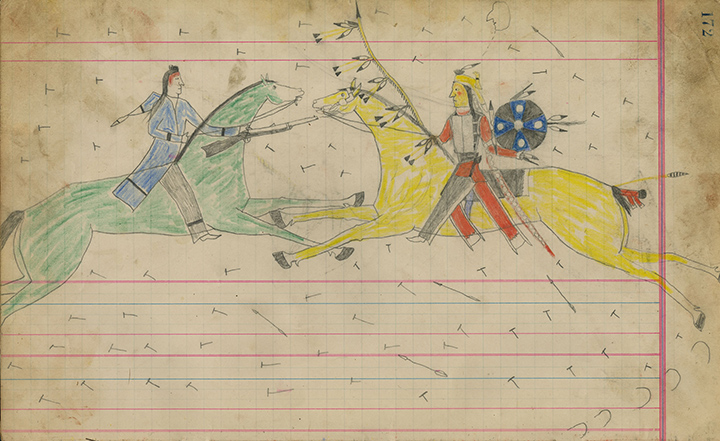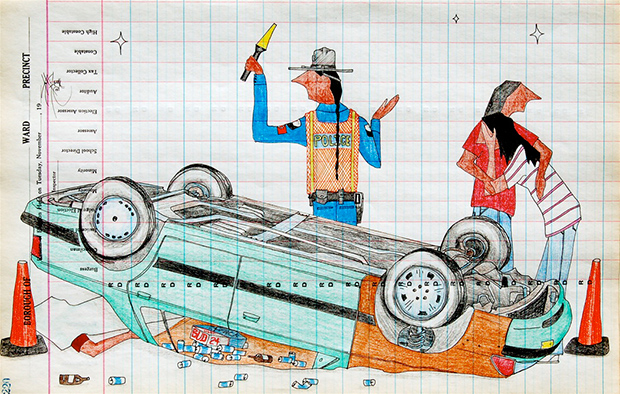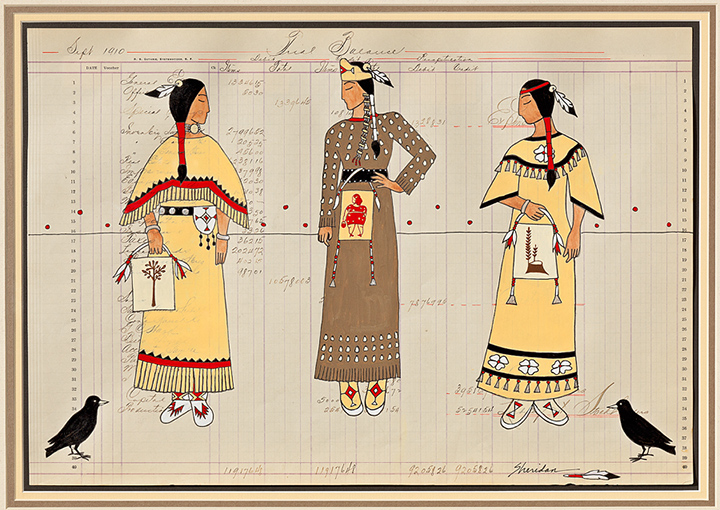By:
- Inga Kiderra
Published Date
By:
- Inga Kiderra
Share This:
‘Alternative Accounts’
Curated by UC San Diego students, Plains Indian ledger art exhibition at San Diego Museum of Art shares Native vision of American history

Cheyenne warrior engaging enemies, by Black Horse (Northern Cheyenne). The Black Horse Ledger, 1879-1885, is on view in “Alternative Accounts” for the first time.
The 19th century was a devastating time on the Great Plains. Massive herds of buffalo, which had once roamed the grasslands in the millions, were slaughtered nearly to extinction, destroying the livelihood of Native peoples. The “Indian Wars” took Native lives directly. Survivors were forced by the U.S. government onto reservations.
As their ancestral way of life disappeared, Indian artists turned from traditional painting on buffalo hide to other media, including paper.
Plentiful and pretty easy to come by were ledgers, or lined accounting books of the sort that shopkeepers used to keep track of their finances. Indian artists filled these ledgers with their stories. At first, continuing in the tradition of buffalo-hide painting, the ledger drawings were representations of war heroism and sacred visions and other public status-building narratives. With time, the books began also to include more private accounts and memories – of ceremonial grandeur, of displacement and reservation life, of courtship and daily doings. Some of the depictions were somber. Some were humorous, almost slapstick.

Budweiser killed more Indians than Custer, by Dwayne Wilcox (Oglala Lakota), 2010.
A small portion of this art and history is now on view at the San Diego Museum of Art, in an exhibition curated by 15 UC San Diego students, under the guidance of Ross Frank, associate professor of ethnic studies in the Division of Social Sciences and director of the Plains Indian Ledger Art project, or PILA.
PILA has been working since 1994 to keep Plains Indian ledger books intact – or, failing that, to at least archive them whole digitally on the PILA website before they’re unbound and their pages sold piecemeal.
On view through May 28, “Alternative Accounts” features examples of 19th-century Plains Indian ledger art, including four volumes from UC San Diego’s Mandeville Special Collections Library newly acquired through PILA, along with the work of contemporary artists who are continuing the ledger tradition today. According to the curatorial statement, the show “offers a rare look at the counter-narrative of America, told through the drawings of its original inhabitants.”
It is also noteworthy, Frank said, that “Alternative Accounts” is showing at an art museum – that the works are being treated, not “just as ethnographic objects,” but as the art they are.
To Learn More:
Plains Indian Ledger Art project
“Alternative Accounts” at the San Diego Museum of Art
Triton alumni magazine story on PILA
The exhibit grew out of a two-quarter course sequence taught by Frank and visual arts lecturer Terri Sowell, “Representing Native America,” offered for the first time in the winter and spring of 2012.
The course, Frank said, attracted students from across campus: not only students from the faculty members’ fields, visual arts and ethnic studies, but also from theater, engineering, history and biology. It was also gratifying, he said, to see a number of Native American students enrolled.
“It’s pretty amazing,” Frank said. “The students worked on the exhibition from conceptual beginning all the way through to putting on the show. And some are continuing to volunteer as presenters for some of the museum’s Art Stops. I have rarely been in an environment where students were so motivated.”
Joseph Herring is one of those students, and he echoes Frank’s sentiments.
Herring, who graduated with a bachelor’s in art history from UC San Diego in 2012 and is now working at Geisel Library as well as the San Diego Museum of Art and the Museum of Photographic Arts, before continuing graduate study in art history in the United Kingdom, said of his work on the exhibit: “I had the chance to write wall labels, create an interactive iPad application for the gallery space, design the exhibition title graphic, and assist on other projects along the way. I've worked on museum exhibitions before, but usually my job was limited to one specific task. This project allowed me the unique opportunity to work on all the different tasks that go into creating an exhibition – and to see it through from start to finish.”

Pow wow girls, tribute to Margaret..., by Sheridan Macknight (Chippewa, Lakota), 2011.
Like Frank, Herring also feels the ledgers themselves and the exhibit are important both for their artistry and for the history they depict. “Native American history,” Herring said, “is usually told from the perspective of outsiders. ‘Alternative Accounts’ through these ledger artworks presents the visual tradition of telling history from a Native perspective.”
Frank said the “Representing Native America” course itself grew out of a remarkable burst of preservation activity the previous year.
In 2011, PILA – supported by the Bradley Foundation and in association with Mandeville Special Collections – was able to acquire its first 19th-century ledger book, the Black Horse Ledger. Drawn in the late 1870s and early 1880s by a well-documented Northern Cheyenne warrior by that name, the Black Horse Ledger is on view for the first time ever in “Alternative Accounts.”
The physical collection has since grown with donations and acquisitions to six volumes, making it, Frank believes, the second largest collection of whole ledgers in the U.S out side of the holding at the Smithsonian museums. The PILA website meanwhile, he says, is set to surpass the Smithsonian as the largest repository of digital images of ledger art.
Share This:
You May Also Like
UC San Diego is Strengthening U.S. Semiconductor Innovation and Workforce Development
Technology & EngineeringStay in the Know
Keep up with all the latest from UC San Diego. Subscribe to the newsletter today.



